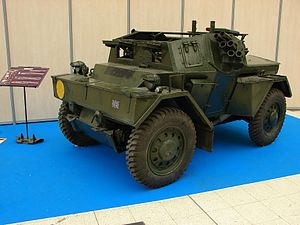| Daimler scout car | |
|---|---|
 Daimler Dingo scout car | |
| Type | Scout car |
| Place of origin | United Kingdom |
| Service history | |
| In service | 1940–1974 |
| Used by | British Commonwealth and associated foreign units in Second World War, other nations post war including the United States, And Kuwait. |
| Wars | |
| Production history | |
| Designer | BSA |
| Designed | 1938/39 |
| Manufacturer | Daimler (Dingo), Ford Canada (Lynx) |
| Produced | 1939–1945 (Dingo), 1942–1945 (Lynx). |
| No. built | 6,626 (Dingo); 3,255 (Lynx) [1] |
| Specifications | |
| Mass | 2.8 long tons (3 tonnes) |
| Length | 10 ft 5 in (3.18 m) |
| Width | 5 ft 7.5 in (1.715 m) |
| Height | 4 ft 11 in (1.50 m) |
| Crew | 2 |
| Armour |
|
Main armament | .303 in (7.7 mm) Bren light machine gun or a .55 in (13.9 mm) Boys Anti-tank Rifle[2] |
| Engine | 2.5 litre 6-cyl Daimler petrol 55 hp (41 kW) |
| Power/weight | 18.3 hp/tonne (13.7 kW/tonne) |
| Transmission | Pre-selector gearbox, five gears forward and five gears reverse |
| Suspension | Independent, coil spring, wheeled 4×4 |
Operational range | 200 mi (320 km) |
| Maximum speed | 55 mph (89 km/h) |
The Daimler scout car, known in service as the Daimler Dingo (after the Australian wild dog), is a British light, fast four-wheel drive reconnaissance vehicle also used for liaison during the Second World War.
- ^ "Lynx total production". Archived from the original on 9 January 2014. Retrieved 30 January 2013.
- ^ 11th Hussars used twin 0.303 (7.7 mm) Vickers K machine guns